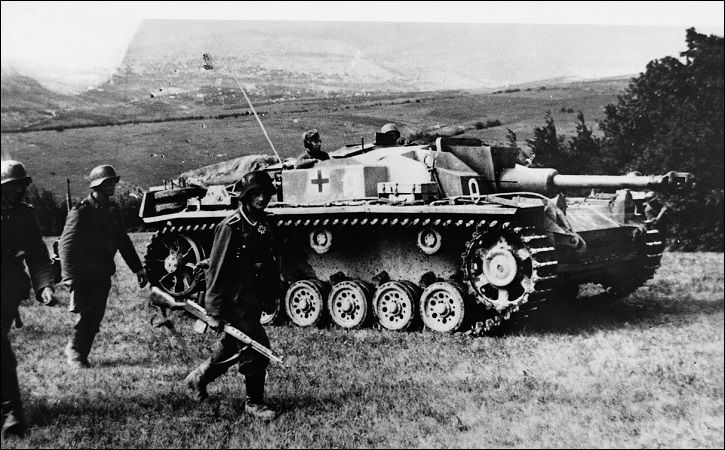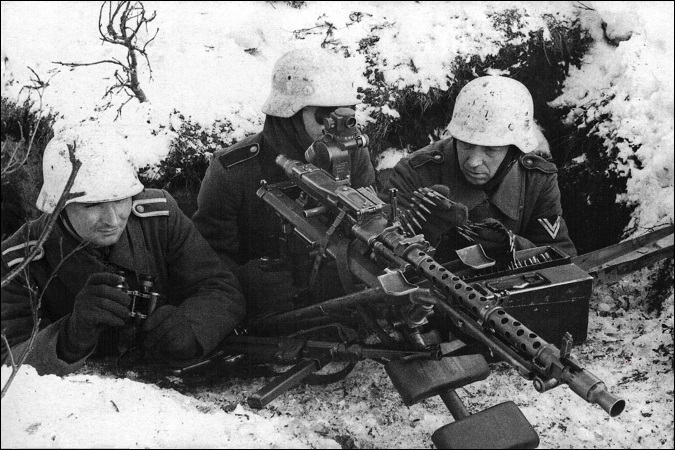Roughly 10% of the German Army’s
combat power was embodied in the Heerestruppen or
General Headquarters Troops.
These were non-divisional units controlled by higher headquarters for
allocation to field armies, corps and divisions as required.
Most were battalions and almost all were motorized or
mechanized. About
half of the HT
units consisted of artillery battalions; the rest were
assault gun battalions, machine gun battalions, engineer
battalions, antitank and antiaircraft battalions, panzer (armored) and
infantry formations, and various specialized units.
Artillery Battalions
• Artillerie-Abteilungen
(motorisiert)
Overall the organization of the
Heerestruppen
artillery battalions was similar to that of
divisional
artillery battalions. Early in the war non-divisional
artillery battalions had howitzers of 150mm caliber or
greater and guns of 105mm caliber or greater. Many
battalions were mixed, e.g. with two batteries of 210mm
howitzers and one of 150mm guns. Battalions with heavier
weapons generally had two or three guns per battery for a total of
six or nine. Later on single-type battalions became more common,
e.g. 9 x 150mm guns in three batteries, each with three
guns. Weapons shortages also compelled the Army to equip
some
Heerestruppen
artillery units with lighter weapons, e.g. the 105mm light
howitzer. Throughout the war, much use was made of captured
weapons, e.g. Czech 150mm howitzers and guns, French 155mm
howitzers, Russian 122mm howitzers and 152mm gun-howitzers,
etc. The handful of super-heavy artillery battalions and
separate batteries constituted a mixed bag, being equipped
with guns and howitzers of 240mm to 600mm caliber, about
half of which were of Czech origin. The
Heerestruppen
artillery included
artillery observation battalions and rocket artillery (Werfer)
units though technically the latter constituted a separate
branch of service that will be described in Part
2.
To control these non-divisional
artillery battalions, specialized
headquarters elements were provided:
The Höheren Artillery-Kommandeur
(motorisiert)
(Motorized Higher Artillery
Commander or Harko)
was assigned at field army level, charged with general
supervision of all the army’s artillery, both divisional and
non-divisional.
The Stab, Artillery-Kommandeur (motorisiert)
(Motorized Artillery Commander or Arko)
was assigned at corps level, responsible for coordinating
all artillery within the corps.
The Stab, Artillery-Regiment (motorisiert)
(Motorized Artillery Regiment Headquarters) was assigned at
corps level to command and control between two and four
non-divisional artillery battalions. In modern parlance it
was a modular unit to which battalions could be assigned as
required for a given task. On occasion it was attached to a
division to coordinate divisional and attached
non-divisional artillery.
Assault Gun Battalions
•
Sturmgeschütz-Abteilungen
Assault gun battalions entered the Army’s order of battle in 1940
and despite being armored units were part of the artillery
branch. They were equipped with the
Sturmgeschütz III self-propelled
assault gun, based on the chassis of the Panzer III tank.
The StuG III was intended to provide the infantry with
mobile direct fire support. Early versions were armed with the low-velocity 75mm/L24 infantry gun, later
replaced by a high-velocity dual-purpose 75mm /L43 or L/48 gun. The gun
was mounted in an armored casement with limited traverse,
which endowed the StuG III with a lower profile than a tank, and made the later version with its
high-velocity gun an effective tank destroyer.

StuG III Ausf. F (75mm/L43 gun) and infantry in Russia, 1942 (Bundesarchiv)
Because it lacked a revolving
turret, the cost to produce an StuG III was only 80% of a
similarly armed tank: one reason why it became the second-most produced German armored vehicle of the war. On average,
the German Army raised one assault gun battalion a month
between 1940 and 1945, but they were in high demand and
there were never enough of them. To fill the gap,
independent assault gun batteries were also raised and
fielded, and when possible they were brought together under
a battalion headquarters. In addition to these
Heerestruppen
assault gun units, many more served in the panzer and
motorized infantry (later panzer grenadier) divisions,
sometimes in place of tanks when the latter were not
available.
Though doctrine called for their
employment en mass, assault gun battalions were usually
attached to infantry divisions and it was common to allot
one battery (7, later 10 x StuG III) to each of the division’s
infantry regiments. By late 1942 the table of organization
called for one platoon in each battery to be equipped with
the StuH III mounting a 105mm howitzer in place of the 75mm
gun, but not all of the thirty-odd assault gun battalions in
existence at the time had these.
Motorized
Machine Gun Battalions •
Maschinengewehr-Bataillone
(motorisiert)
Fourteen
motorized machine gun battalion existed in 1939 and there
were never more than fifteen in the Army's order of battle. Initially they
embodied three motorized companies and two motorcycle
platoons with a total of 44 heavy machine guns (HMG), plus an
antitank company. Later on an 81mm mortar platoon was added.
Often a pioneer (combat engineer) company was attached as
well, to construct firing points and obstacles.

The MG 34 in heavy machine
gun configuration (Bundesarchiv)
Some
machine gun battalions were eventually converted to
motorcycle infantry battalions and others to motorized
infantry battalions; the ones that remained in their
original configuration tended to be employed as mobile
reserves. The machine gun was the 7.92mm MG 34 and later the
7.92mm MG 42, both of which were general-purpose designs
with quick-change barrels that could be fed by drum or belt.
When fitted with a bipod, sling and drum magazine they were
classified as light machine guns (LMG); when issued with a tripod,
telescopic sight and belt ammunition they were classed as
HMG.
Engineer Battalions
•
Pionier-Bataillone
(motorisiert)
Engineer battalions of the
Heerestruppen were mostly of two types: pioneers (combat
engineers) and
bridging engineers. The former were similar to the motorized
pioneer battalions found in the motorized infantry divisions
and in addition to their field engineering mission they
served as assault troops. As with the artillery,
there was a specialized headquarters element to command and
control them: the Stab Pionier-Regiment (motorisiert)
(Motorized Engineer Regiment Headquarters).
Heerestruppen
engineer units also included assault boat and landing craft
companies.
● ● ●